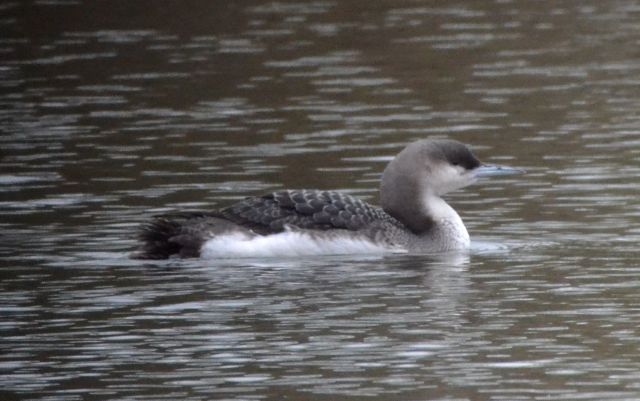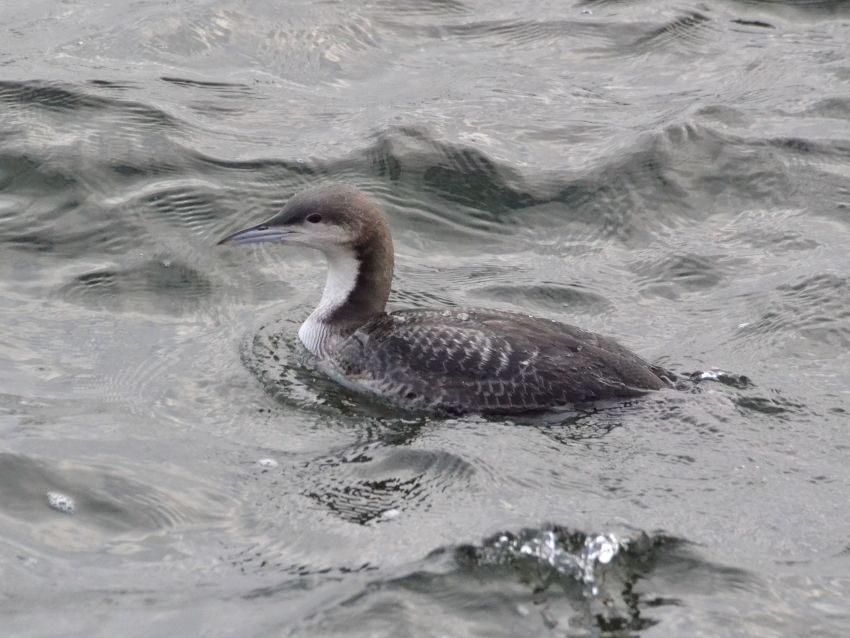For me this Pacific Diver has been December’s stand out national bird, fitting all my usual twitch criteria. So it was just a matter of when to get up and go for a potential 13th British list addition and 8th lifer of the year. Today, after dismal grey conditions over much of the 11 days since the Nearctic nicety’s arrival in South Wales, the winter solstice was forecast to offer an uplifting weather window. So there was no “Get Out The Door” scenario this time … hitting the road was all carefully planned.
I normally expect the scarcer Divers – White or Yellow-billed and Pacific – to be reported as offshore blobs from locations such as northern Scotland, Cornwall or southern Ireland. Those places are way beyond my preferred range, so inland reservoir sightings are of great interest to me. South Wales has some past Pacific form, since the second ever British record came from Pembrokeshire in 2007. This post’s second Welsh record, a juvenile has attracted much attention, involving the logistics of connecting at a site with “no general access”. As part of my own planning I gained guidance from a regular birding colleague on how to “trespass” successfully, in the merely bijou sense of course.
Pacific Diver (or Loon) is the North American equivalent of the group’s Eurasian Black-throated species, from which it was split in 1985. Between them the two breed in the tundra zone right around the northern hemisphere. Nearctic birds mostly winter down the western coasts of the Americas, but a few as always stray in the wrong direction. Prior to today this was the last of the world’s five Diver species I had yet to record.
Today’s bird, which I believe is the 10th British record (per BTO), appears to be settled at Eglwys Nunydd Reservoir (SS 794848), close by J38 of the M4 motorway near Port Talbot in Glamorganshire. The 110 ha (260 acre) facility was constructed in 1963 to provide cooling water for the adjacent large steelworks. Notable for its breeding bird life, the site has been a designated SSSI since 1972 but there is no authorised public access. This reservoir is managed by private recreational bodies for angling and sailing.
I arrived on-site in the late morning. The request on RBA was to use only the nearby Margam Cemetery car park (SS 79510 85941 – SA13 2NR), an instruction which has since changed (15th Jan). In respect of that I removed some detail from this post as it was first published. After meeting three birders from Northampton we attempted to follow directions that had circulated on Twitter. Upon negotiating the vagaries of finding our way into the “area of no general access” we were not alone. A local birder soon engaged who said the bird was being watched at the southern end of the water body.
He told us to go through a gate at the north-west corner of the reservoir that our quest favours (see here) onto the western perimeter, in an “everyone else does” sort of way. Apprehensive that we might be intercepted by site security we legged it at pace towards where people were visible in the distance. About three quarters of the way along another local birder walking towards us pointed out the Pacific Diver out on the water.





Connects do not get better than what next transpired. My 373rd British bird swam to within 20 metres of the perimeter then dived its way all the way back to the north-west corner, tracked as it went by the nine picture taking birders that our group suddenly became. It was quite plain that many others had visited the site before us and do so anyway, and that at least on weekdays there is nothing to stop it. We all just wanted to see a rare bird after all. It wouldn’t have hurt for access and a charity bucket to be arranged, would it?


Pacific Divers may be up to 20% smaller than Black-throated (per the Helm guide to confusion species) and have a shorter, slimmer bill. A confirmatory diagnostic is quoted as a dark “strap-line” at the juncture of the throat and neck, which the left hand picture (above) shows. What further plumage diagnostics might be exhibited in juveniles I am not sure, and so will just present a comparison picture here of each species.
Loathing the dark season as I do in my circumstances, there could have been no better way to hurdle the solstice than today’s experience. It represents the successful negotiation of another mid-winter nadir. Soon the renewed challenges of evolved achievement will rise once more from these empty annual weeks of endurance and psychological management. Looking back through any year I mostly recall the wildlife observed, and whatever its other frustrations may have been, 2021 has been quite exceptional in that regard. Onward then!
Check-list of my previous national Diver (or Loon) records
Black-throated Diver
- Bedford – Nov 1993
- Farmoor Reservoir, Oxon – May 2015 (see here)
- Redditch, Worcs – Jan 2019 (see here)
Red-throated Diver (or Loon)
- Blackwater Estuary, Essex – Dec 1988
- Farmoor Reservoir, Oxon – Oct 2012
- Pagham Lagoon, Sussex – Oct 2020 (see here)
Great Northern Diver (or Common Loon)
- Farmoor Reservoir, Oxon – Jan & Mar 1989, Feb 1990, Nov 2010, Dec 2011, Jan 2012, Dec 2015, Dec 2021 to Mar 2022
- Portland Harbour, Dorset – Jan 1992
- Pangbourne, Oxon – Dec 2018 & Jan 2019 (see here)
White-billed Diver (or Yellow-billed Loon)
- Bardney, Lincs – Jan 2017 (see here)



